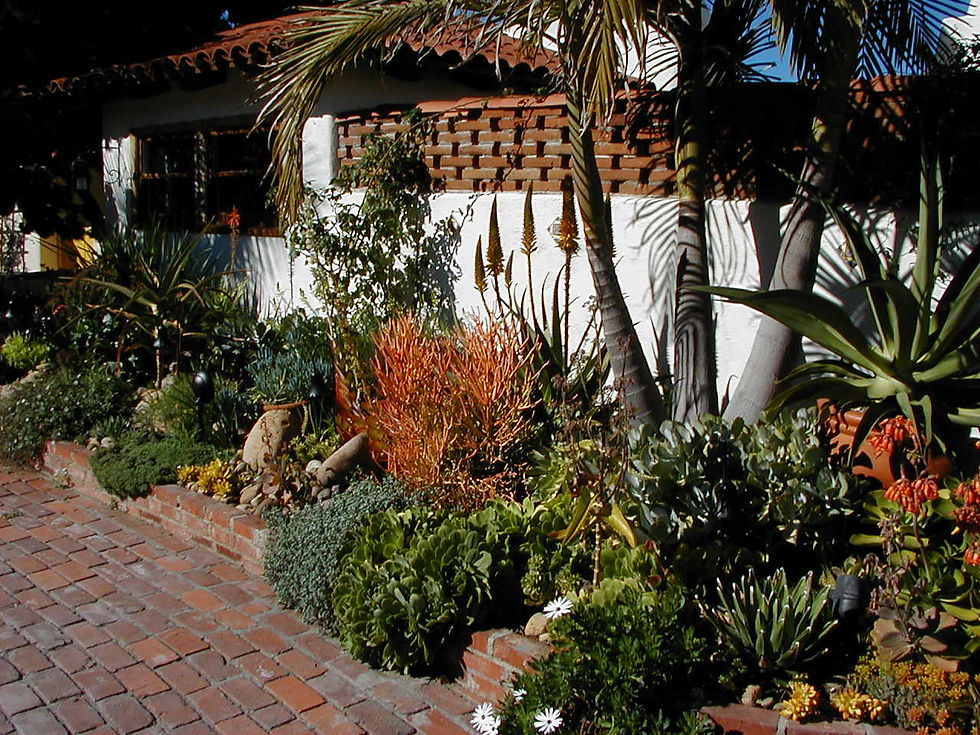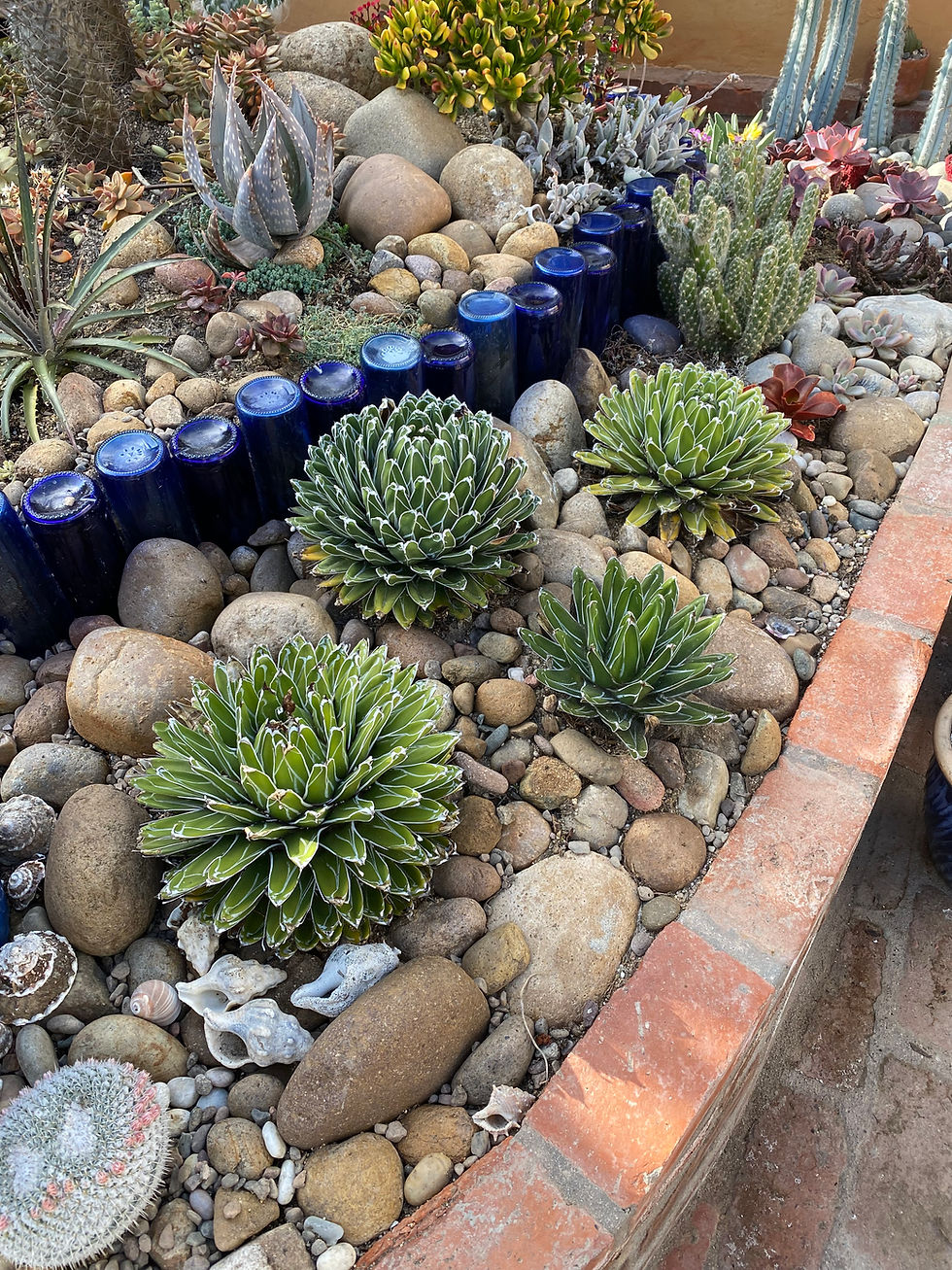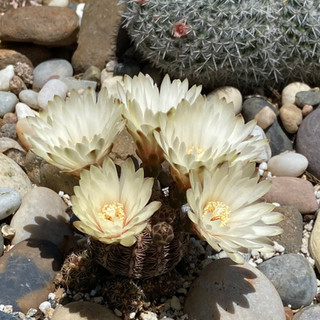MY LIFE WITH PLANTS - Front Garden Refresh
- Jim Bishop
- Nov 1, 2024
- 6 min read
Words and pictures by Jim Bishop, for Let's Talk Plants! November 2024.

In 1998, when we moved into our 1939 Spanish Colonial Revival house in Mission Hills, we found that despite having an acre of land, there was little space available for landscaping and planting. The only area suitable for this purpose was a narrow raised bed between the brick sidewalk in front of the house and the protective front wall of the courtyard. The previous owner had planted this space with pansies, nine king palms, Archontophoenix alexandrae, planted in three clusters of three palms each, and two Thunbergia grandiflora vines in an attempt to enhance the house's appeal for sale. Upon settling in, it became evident that there wouldn't be enough space for the palms once they reached maturity. Consequently, one of my first projects was to remove some of the brick paving in front of two low walls at opposite ends of the house and establish two additional planting beds to accommodate one set of palms in each. While I managed to maintain the pansies through spring by diligently deadheading and hand watering them, I gradually replaced them with some of my preferred perennial plants at that time.

Through the years, the plants in this area have been frequently renewed and replaced as my preferences and tastes in plants evolved. The variety of plantings transitioned from perennials and annuals to shrubs, climbing roses, South African bulbs, and any new small plant that caught my eye. Despite the lack of space for trees and shade, the white front wall faced directly south, reflecting intense sunlight from autumn through winter and early spring.


It dawned on me that this could be a perfect spot for succulents and similar plants. Slowly but surely, they replaced the existing plantings. I introduced a small Bismarckia noblis palm with the hope that it would one day dominate the front of the house and flourish in the intense heat. While the king palms continued to grow, providing some shade in the summer, their roots eventually filled the beds and absorbed all the water, making it challenging to grow even succulents. Around the same time, I started cultivating bromeliads and discovered that some thrived in full sun and required minimal root space.
By 2015, the palm trees were struggling to receive sufficient water for a healthy appearance, as their tops had grown tall enough to be affected by the westerly winds, resulting in a tattered look. This, combined with the water shortage during the drought, made them increasingly unappealing. By 2018, one of the palm trees had begun to lean against the front wall, while several others had developed narrowed trunks due to the lack of water, a condition they typically do not recover from.

For a decade or more the succulents in front looked great with minimal maintenance and a weekly watering. But agaves bloom and die or grow too big for their space and potted plants get root bound.
The decline of many of the plants was starting to show...





Our house, situated at the bottom of a cul-de-sac, is the only flat area on the street for parking. Additionally, a 6-foot-wide, 40-foot-long sidewalk in front of our property made it a convenient spot for neighbors, contractors, lawn workers, guests, and delivery services to park and unload. While we were not required to provide a sidewalk, ours was a rare feature on our street. A disagreement with our neighbor arose over their 70-foot-tall timber bamboo, planted less than 10 feet from our house. Eventually, the city's brush management control mandated its removal, resolving the issue. However, in response, our neighbor persuaded the city to demand the removal of our existing three Italian cypresses and 80-year-old crooked juniper, which provided the only shade for our house. Recognizing the importance of shade, we decided, after careful consideration and a review of the tree guidelines, to remove the juniper and raise the cypresses higher off the ground. Although the trees posed minimal fire risk, being surrounded by paving and not in contact with any structures or the canyon behind our house, we looked for a contractor to trim them higher. Given that the task exceeded our capabilities, we saw an opportunity to address other concerns in the front garden requiring a contractor. This led us to opt for the removal of the king palms, widening of the front beds, and resolving various issues related to the front work and steps of the house simultaneously.
Brickwork
The contractor started working in November 2022 and finished by January 2023. I was amazed to discover that while looking for additional water, the roots of the palm trees in the side beds had grown between the layers of stucco on the short walls. Additionally, on the main front wall, the stucco applied by a previous owner was not done correctly, resulting in loose sections and some parts falling off.
Laying out the new beds. From Left to right:
Front sidewalk before.
The next four are marking the new areas.
Six and seven are after widening and raising the beds.
Number eight is the widened western bed.
Number nine is the widened eastern bed.
This is just inside the gate from the street into our front patio. Originally the bricks ramped with a step down into the patio. Many people tripped here over the years. The area was lowered to match the patio and the step moved to be just inside the gate. Decorative tile was added to make the step more noticeable.
The new ramped walkway replacing several awkward steps and ramps and failing brick walls.
Stucco, Paint and Tile
I attempted to hire a contractor for the stucco repair job, but the quotes were either too high, too low, or too costly. Therefore, I opted to take on the task myself. Upon removing the deteriorating stucco from the front wall, I discovered that, aside from a single crack, the original 1939 stucco was in good condition and could be reused. However, at the upper section of the wall, some parts had been patched with concrete that was impossible to remove. I made the decision to paint the lower part of the wall in ochre to decrease the reflected sun, install a row of decorative tiles above it, and repair the stucco on the upper section of the wall.
Falied stucco and tile work.

We added decomposed granite mixed with an organic planting mix to the front beds. The dry creek-bed, which was initially installed a few years ago, was repositioned and extended for both plant access and aesthetic purposes.
To improve visibility of the garden and accessibility, we raised the height of the short brick walls surrounding the raised beds. Additionally, we addressed a potential trip hazard by relocating a step behind the front gate and enhancing its visibility with decorative tile. In the side yard, we replaced several steps with a ramp to facilitate moving trashcans to the street.
We swapped the pair of king palms in the side beds with Madagascar Ocotillos, Alluaudia procera.
One final project was wrapping the painted wall and tile border around the entranceway and into the front patio.

Planting
After months of work the bed was finally ready for planting.




Aloe speciosa was relocated from the bottom of the garden and bloomed the first year after being moved.

Agave victoriae-reginae added to the front.







Tall Allauadias replaced the king palms at either ends of the property. I had to visit a lot of nurseries to find tall ones. These were dug out someone's garden and resold.
I ended up hiring one of the people that delivered the Allauadias and he's been my garden helper for the last year and a half.









Aloe speciosa was relocated from the bottom of the garden and bloomed the first year after being moved.






Backlit opuntia...this one with white hairs is spineless.

I really wanted to put a grouping of Pachyhpodium geayi in the front. Hopefully someday these will bloom with large white fragrant flowers. They can reach 10 feet in height. They echo the Dyckia 'cherry cola' dark foliage in front.
More Specimen Plants









































































































Comments